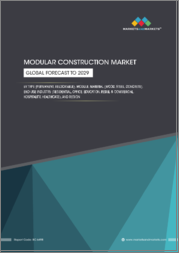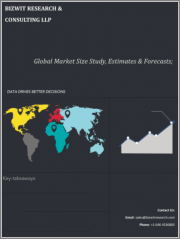
|
시장보고서
상품코드
1362923
미국의 모듈 공법 시장 규모, 점유율, 동향 분석 보고서 : 제품별, 재료별, 용도별, 부문별 예측(2023-2030년)U.S. Modular Construction Market Size, Share & Trends Analysis Report By Product (Relocatable, Permanent), By Material (Wood, Steel, Concrete), By Application (Residential, Commercial, Industrial), And Segment Forecasts, 2023 - 2030 |
||||||
미국 모듈 공법 시장의 성장과 동향
Grand View Research, Inc.의 최신 보고서에 따르면 미국 모듈 공법 시장 규모는 2023년부터 2030년까지 CAGR 7.8%로 성장하여 2030년에는 191억 7,000만 달러에 달할 것으로 예상됩니다.
미국 건설업계에서 오프셋 건축의 채택이 확대되고 있기 때문입니다.
미국 건설 산업은 신기술과 신소재의 도입으로 빠르게 변화하고 있습니다. 모듈식 건설, 오프사이트 건설, 자가 수리 콘크리트, 열교, 태양광발전 유약, 키네틱 풋폴, 키네틱 로드, 예측 소프트웨어, 3D 모델링, 클라우드 협업, 자산 매핑 등 다양한 발전이 이루어지고 있습니다. 등이 있습니다.
성장하는 건설 산업은 베이비붐 세대의 은퇴와 밀레니얼 세대의 타 직종으로의 이직으로 인해 숙련공 부족에 직면할 가능성이 높습니다. 또한, 외국인 건설 노동자의 유입이 감소하고 있는 것도 숙련된 인력 확보에 악영향을 미칠 것으로 예상됩니다. 노동력 부족 문제를 해결하기 위해 업계는 모듈식 건축, 조립식, 조립식 건축 등 오프사이트 생산 방식으로 전환하고 있습니다. 이러한 구조물은 기존 철골 구조물보다 큰 이점을 제공합니다.
모듈 건축의 제조 공정은 기술 사양을 고려한 구조물 설계부터 시작됩니다. 건축가와 엔지니어는 StaadPro, AutoCAD, MBS, Tekla와 같은 소프트웨어를 사용하여 조립식 구조물을 설계합니다. 모듈 공법 설계를 위해 자체적으로 건축가와 엔지니어를 보유하고 있는 제조업체도 있고, 타사 벤더의 건축가와 엔지니어로부터 설계를 받는 제조업체도 있습니다. 설계는 고객에게 보내져 승인을 받은 후 생산이 시작됩니다. 모듈 구성요소는 통제된 오프사이트 환경에서 동시에 터파기와 굴착을 통해 건설됩니다. 모듈이 완성된 후 최종 현장으로 운송됩니다.
모듈 공법은 작업자 안전, 품질, 지속가능성 측면에서 건축 산업을 변화시키고 있습니다. 혁신적인 첨단 건축 자재, 3D 프린팅 기술, 새로운 조립 기술을 광범위하게 도입하고 있습니다. 오프사이트 건축의 첫 번째 부분은 포드 건축과 모듈 공법을 포함한 용적식 건축으로 구성됩니다. 이 기술을 통해 주택이나 방과 같은 무거운 3D 구조물을 조립식으로 제작할 수 있습니다.
두 번째 부분은 공장에서 바닥, 지붕판, 벽에 사용되는 평평한 패널을 제조하는 패널화 건설입니다. 현대의 상업용 건물에서 이 기술은 칸막이 및 지지부재 설치에 사용됩니다. 이에 따라 다양한 스타트업들이 기존 건축 방식을 대체할 수 있는 모듈 공법 솔루션을 제공하고 있습니다.
미국 모듈 공법 시장 보고서 하이라이트
- 재료별로는 철강 부문이 2022년 41.4%로 가장 높은 시장 점유율을 차지할 것으로 예상됩니다. 철강은 고강도, 내구성, 연성, 내진성, 빠른 설치 등 우수한 기계적, 화학적 특성과 함께 가공이 용이해 모듈 공법에서 선호도가 높습니다.
- 용도별로는 주거용이 예측 기간 동안 가장 빠른 CAGR 9.2%로 성장할 것으로 예상됩니다. 이는 모듈 공법이 빠른 조립이 가능하고, 까다로운 설계를 실현할 수 있으며, 고객의 요구 사항을 충족하는 독특하고 맞춤형 주택을 건설할 수 있는 등 모듈 공법이 기존 방식에 비해 몇 가지 장점을 가지고 있기 때문입니다.
- 제품별로는 영구적 모듈 공법이 2022년 70.6%의 최대 매출 점유율로 시장을 장악할 것으로 보입니다. 미국 중산층의 1인당 소득 증가와 자금 조달의 용이성으로 인해 미국에서 주택을 소유하려는 경향이 강해지고 있습니다. 이는 미국 모듈러 주택 시장의 영구적 부문 성장에 긍정적인 영향을 미치고 있습니다.
- 모듈 공법 기업들은 주로 사내에 영업팀과 담당자를 두고 잠재 고객과 직접적으로 접촉하는 직접 판매에 주력하고 있습니다. 이 접근 방식은 인간관계를 구축하고, 고객의 요구 사항을 이해하고, 맞춤형 솔루션을 제공하는 데 도움이 됩니다. 직접 판매는 대규모 프로젝트나 특정 산업 및 고객을 대상으로 할 때 효과적입니다.
- 이 시장에는 많은 세계 기업과 지역 기업이 존재하기 때문에 기업 간 경쟁이 치열합니다.
목차
제1장 조사 방법과 범위
제2장 주요 요약
제3장 미국의 모듈 공법 시장 변수, 동향, 범위
- 시장 계통 시장
- 밸류체인 분석
- 제조업 동향
- 판매 채널 분석
- 원재료 분석
- 규제 체계
- 기술 개요
- 미국의 모듈 공법 시장 - 시장 역학
- 시장 성장 촉진요인 분석
- 시장 성장 억제요인 분석
- 업계 과제
- 미국의 모듈 공법 시장 - Porter's Five Forces 분석
- 공급 기업의 교섭력
- 구매자의 교섭력
- 신규 참여업체의 위협
- 대체의 위협
- 경쟁 기업 간의 경쟁 관계
- 미국의 모듈 공법 업계 분석 - SWOT에 의한 PESTLE
- 정치적 상황
- 경제 상황
- 사회적 상황
- 기술적 상황
- 환경 상황
- 시장 디스럽션 분석
제4장 미국의 모듈 공법 시장 : 재료 추정·동향 분석
- 중요한 포인트
- 재료 시장 점유율 분석, 2022년 및 2030년
제5장 미국의 모듈 공법 시장 : 제품 추정·동향 분석
- 중요한 포인트
- 제품 시장 점유율 분석, 2022년 및 2030년
제6장 미국의 모듈 공법 시장 : 용도 추정·동향 분석
- 중요한 포인트
- 용도 시장 점유율 분석, 2022년 및 2030년
제7장 경쟁 상황
- 주요 기업, 그 최근의 동향 및 업계에 대한 영향
- 주요 기업/경쟁 분류
- 기업의 시장 포지션 분석
- 기업 히트맵 분석
- 전략 매핑
- 회사 리스트
- Sekisui House Ltd.
- CIMC Modular Building Systems Holdings Co., Ltd.
- Lendlease Corporation
- Guerdon, LLC
- Skanska
- WillScot Mobile Mini Holdings Corp.
- ATCO Ltd
- Fluor Corporation
- JL Construction
- Palomar Modular Buildings
U.S. Modular Construction Market Growth & Trends:
The U.S. modular construction market size is expected to reach USD 19.17 billion by 2030, growing at a CAGR of 7.8% from 2023 to 2030, according to a new report by Grand View Research, Inc.. This is owing to the growing adoption of off-set building practices in the U.S. construction industry.
The U.S. construction industry is witnessing rapid changes with the introduction of new technologies and materials. Some of the advancements in the industry include modular or off-site construction, self-healing concrete, thermal bridging, photovoltaic glaze, kinetic footfall, kinetic roads, predictive software, 3D modeling, cloud collaboration, and asset mapping.
The growing construction industry is likely to face a shortage of skilled labor owing to the retiring baby boomers and millennials opting for other professions. In addition, a decreasing influx of foreign-born building workers is projected to negatively influence the availability of skilled workers. To address the issue of labor shortage, the industry is moving toward off-site production methods such as modular buildings, prefabrication, and pre-engineered buildings. These structures offer substantial advantages over traditional steel buildings.
The manufacturing process of modular buildings starts with the designing of the structures by considering the technical specifications. The architects and engineers design prefabricated structures using software such as StaadPro, AutoCAD, MBS, and Tekla. For designing modular structures, some manufacturers have in-house architects and engineers whereas some get designs from third-party vendors' architects and engineers. The designs are sent to the customers for approval, after which the production is initiated. Module components are built in a controlled offsite environment while conducting grading and site excavation at the same time. After the completion of modules, they are transported to the final site.
Modular construction transforms the building industry, in terms of worker safety, quality, and sustainability. It incorporates a range of innovative advanced building materials, 3D printing technology, and new assembling techniques. The first part of offsite building comprises volumetric construction, which includes pod and modular construction. This technique permits the prefabrication of heavy 3D structures such as homes and rooms.
The second part involves panelized construction, under which the factory manufactures flat panels for use in floors, roof panes, and walls. Modern commercial buildings use this technique to install partitions and support elements. Therefore, various start-ups offer modular construction solutions to replace conventional building methods.
U.S. Modular Construction Market Report Highlights:
- Based on material, the steel segment held the highest market share of 41.4% in 2022. Steel exhibits excellent mechanical and chemical properties such as high strength, durability, ductility, seismic resistance, and fast installation, along with offering ease of fabrication, due to which it's highly preferred in modular construction.
- Based on application, the residential application is forecasted to grow with the fastest CAGR of 9.2% over the forecast period. This is due to several advantages of modular construction over conventional methods as modular construction allows rapid assembly, feasibility in terms of challenging designs, and construction of unique and customizable homes that fulfill the requirements of customers
- Based on product, the permanent modular construction dominated the market with the largest revenue share of 70.6% in 2022. An increase in per capita income among the middle-income group in the U.S. and the easy availability of finances are some factors responsible for the prevailing trend of owning a house in the country. This, in turn, is positively influencing the growth of the permanent segment of the modular construction market in the U.S.
- Modular construction companies mainly engage in direct sales, where they have an in-house sales team or representatives who directly engage with potential customers. This approach involves building relationships, understanding customer requirements, and providing tailored solutions. Direct sales can be effective for larger projects or when targeting specific industries or clients
- The intensity of competitive rivalry among companies in this market is high as it is characterized by the presence of a large number of global and regional players
Table of Contents
Chapter 1. Methodology and Scope
- 1.1. Research Methodology
- 1.2. Research Scope & Assumption
- 1.3. Information Procurement
- 1.3.1. Purchased Database
- 1.3.2. GVR's Internal Database
- 1.3.3. Secondary Sources & Third-Party Perspectives
- 1.3.4. Primary Research
- 1.4. Information Analysis
- 1.4.1. Data Analysis Models
- 1.5. Market Formulation & Data Visualization
- 1.6. List of Data Sources
Chapter 2. Executive Summary
- 2.1. Market Outlook, 2022 (USD Billion)
- 2.2. Segmental Outlook
- 2.3. Competitive Insights
Chapter 3. U.S. Modular Construction Market Variables, Trends & Scope
- 3.1. Market Lineage Market
- 3.2. Value Chain Analysis
- 3.2.1. Manufacturing Trends
- 3.2.2. Sales Channel Analysis
- 3.2.3. Raw Material Analysis
- 3.3. Regulatory Framework
- 3.4. Technology Overview
- 3.5. U.S. Modular Construction Market - Market Dynamics
- 3.5.1. Market Driver Analysis
- 3.5.2. Market Restraint Analysis
- 3.5.3. Industry Challenges
- 3.6. U.S Modular Construction Market - Porter's Five Forces Analysis
- 3.6.1. Bargaining Power of Suppliers
- 3.6.2. Bargaining Power of Buyer
- 3.6.3. Threat of New Entrants
- 3.6.4. Threat of Substitution
- 3.6.5. Competitive Rivalry
- 3.7. U.S Modular Construction Industry Analysis - PESTLE by SWOT
- 3.7.1. Political Landscape
- 3.7.2. Economic Landscape
- 3.7.3. Social Landscape
- 3.7.4. Technological Landscape
- 3.7.5. Environmental Landscape
- 3.8. Market Disruption Analysis
Chapter 4. U.S. Modular Construction Market: Material Estimates & Trend Analysis
- 4.1. Key Takeaways
- 4.2. Material Market Share Analysis, 2022 & 2030
- 4.2.1. Wood
- 4.2.2. Steel
- 4.2.3. Concrete
- 4.2.4. Others
Chapter 5. U.S. Modular Construction Market: Product Estimates & Trend Analysis
- 5.1. Key Takeaways
- 5.2. Product Market Share Analysis, 2022 & 2030
- 5.2.1. Relocatable
- 5.2.2. Permanent
Chapter 6. U.S. Modular Construction Market: Application Estimates & Trend Analysis
- 6.1. Key Takeaways
- 6.2. Application Market Share Analysis, 2022 & 2030
- 6.2.1. Residential
- 6.2.2. Commercial
- 6.2.3. Industrial
- 6.2.4. Healthcare
- 6.2.5. Educational
Chapter 7. Competitive Landscape
- 7.1. Key Players, their Recent Developments, and their Impact on Industry
- 7.2. Key Company/Competition Categorization
- 7.3. Company Market Position Analysis
- 7.4. Company Heat Map Analysis
- 7.5. Strategy Mapping
- 7.6. Company Listing
- 7.6.1. Sekisui House Ltd.
- 7.6.1.1. Company Overview
- 7.6.1.2. Financial Performance
- 7.6.1.3. Product Benchmarking
- 7.6.1.4. Strategic Framework
- 7.6.2. CIMC Modular Building Systems Holdings Co., Ltd.
- 7.6.3. Lendlease Corporation
- 7.6.4. Guerdon, LLC
- 7.6.5. Skanska
- 7.6.6. WillScot Mobile Mini Holdings Corp.
- 7.6.7. ATCO Ltd
- 7.6.8. Fluor Corporation
- 7.6.9. JL Construction
- 7.6.10. Palomar Modular Buildings.
- 7.6.1. Sekisui House Ltd.
(주말 및 공휴일 제외)

















